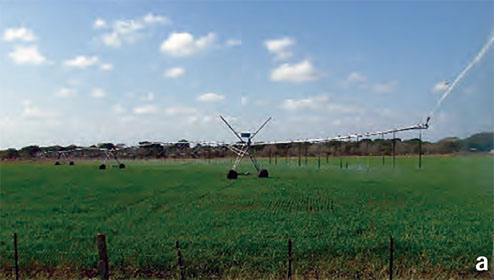Production of registered seed of rice variety ‘SOBERANA FL’ under direct sowing and pressurized irrigation with central pivot
Abstract
In Venezuela, more than 90% rice seed and grain production is based on the flood irrigation (IR) production system with broadcast seeding using pregerminated seed. In this regard, Benacchio and Avilan (1991) estimate that in the country there are in total approximately 2,425,000 hectares suitable for rice cultivation, of which 42% are considered without important limitations, 46% with certain limitations for production, while that 12% have significant physical limitations.
The same authors indicate that the main producing regions are located in the Central Plains (Guárico) and the Western Plains (Portuguesa, Cojedes and Barinas). There is potential to increase the rice planting area in the states of Barinas, Portuguesa and Apure, which represent 60% of the area, followed by Zulia, the Federal Territory Delta Amacuro, Guárico and Cojedes with 30% and the remaining states with the 10%.
The implementation of the current production system with conventional tillage and flood irrigation would not allow the sustainability of the system due to the negative impact it exerts on, mainly the systems: a.) Soils, because it increases erosion, FAO, 2004 indicates that worldwide this factor has contributed to the destruction of 430 million hectares, (30% of the cultivated area); soil losses are around 30-50 tons / hectare / year; there is also a marked decrease in the content of organic matter and alteration of the physical, chemical and biological properties of the soil, as well as a greater consumption of fuel and use of labor. Regarding the system b.) Water, the low efficiency of flood irrigation allows an indiscriminate use of it. For their part, Ferreira and Christofidis, (1999) indicate that the efficiency of flood irrigation is low and is around 45%. In this sense, the same authors add that a 1% increase in efficiency in developing countries would mean an economy of up to 200,000 liters / farmer / hectare / year. Irrigation used in a rational way could promote an economy of approximately 20% water and 30% energy consumed.
References
Benacchio, S. y W. Avilan. 1991. Zonificación agroecológica del cultivo del arroz en Venezuela. Publicaciones FONAIAP.
http://www.ceniap.gov.ve/pbd/monografias/benacchios/ zonificacion%20arroz.pdf. Acceso septiembre 2017. FAO. Perspectiva de la producción mundial de arroz, 2004. http://www.fao.org/arroz/perspectivas. Acceso septiembre 2017.
Gassen, D. y F. Gassen. 1996. Plantio direto – o caminho do futuro. Passo Fundo: Aldeia Sul.
FEDEAGRO. 2017. Producción de arroz en Venezuela. (En línea). Consultado septiembre 2017. Disponible http://www.fedeagro.org/produccion/Rubros.asp Ferreira L. e D. Christofides. 1999. O uso da irrigação no Brasil: o estado das águas no Brasil, Brasília. Agencia Nacional de energía elétrica. Disponible en: HTTP:// www.iica.org.uy. Acceso em septiembre 2017.
Red de agro-meteorología del INIA, Estación Bancos de San Pedro, Calabozo estado Guárico. http:// www.inia.gov.ve/index.php/institucional-inia/redde-agrometeorologia-del-inia, en línea consultado septiembre 2017).
Righes A. 2000. Água: sustentabilidade, uso e disponibilidade para irrigação. Ciência e Ambiente. Santa Maria-RS, V. 21, n. 1, p. 90-102.


